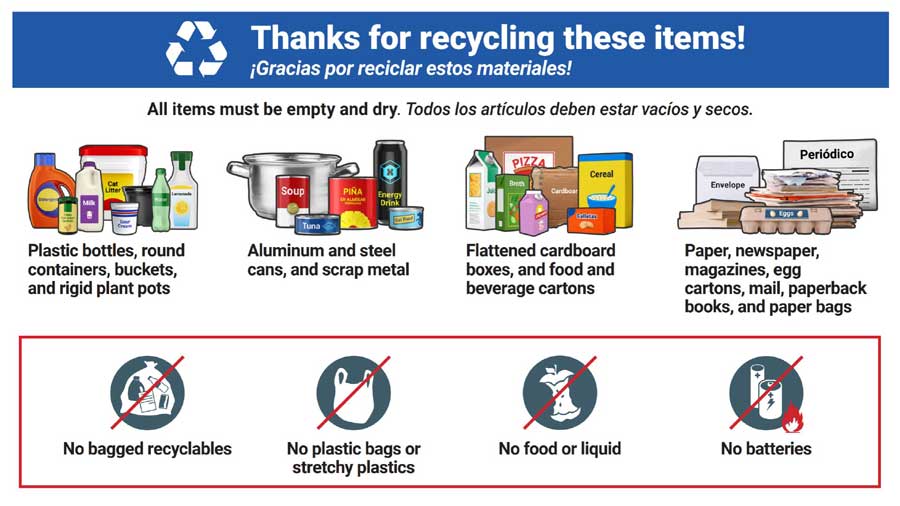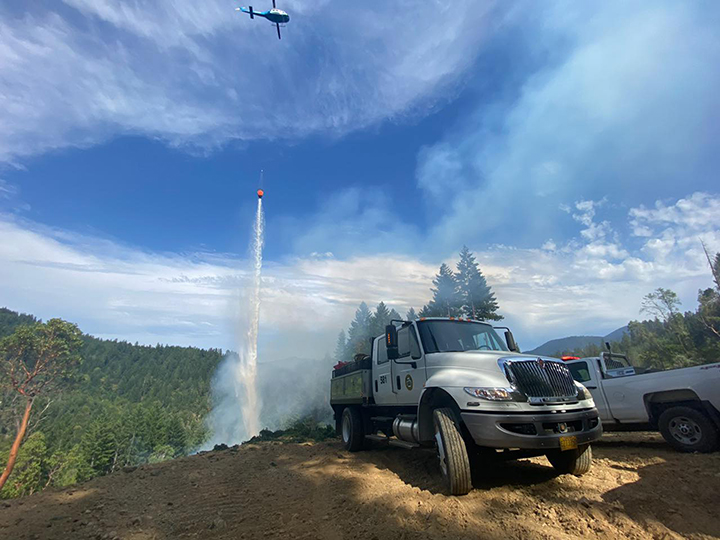Air tankers flying from base at Medford airport to fight Flat Fire
Published 5:00 pm Tuesday, July 18, 2023

- Millie Allison, 6, of Grants Pass, shields herself from the dust and noise kicked up from an air tanker in Medford Monday.
Daniel Allison and his young family watched from behind a perimeter fence Monday at the Rogue Valley International-Medford Airport as DC-10 air tankers took off and landed.
The tankers stopped at a base on the airport’s east side for about 30 minutes to take on thousands of gallons of retardant to drop on the Flat Fire burning near Agness, about 70 miles away.
Business was brisk.
“This is like my childhood, watching them come in and go out all summer long during fire season,” said Allison, a Transportation Security Administration testing engineer who previously lived near a tanker base in the Redmond area.
Now he was showing his own children. As they stood there, the blast of air from a departing jet blew sand and debris in their faces.
As it turned out, Allison had been out rafting Sunday on the Rogue River near Hellgate Canyon west of Merlin as tankers flew overhead to the fire.
“They were actually coming right over us,” he said.
There are two air tanker bases at the airport: one on the east side off of International Way for the “big guys” — DC-10s — and one on the airport’s northwest side, at 600 Nebula Way, for smaller tankers. They’re operated by the U.S. Forest Service, in cooperation with other agencies, including the Oregon Department of Forestry.
On Monday afternoon, three tankers were working the fire, which started about 6 p.m. Saturday and had topped 8,000 acres as of Monday night. The three tankers included two DC-10s capable of delivering up to about 9,400 gallons of retardant, and an MD-87 capable of delivering 3,000 gallons of retardant. The planes, which displayed distinctive tails painted orange, drop red-colored retardant with the help of a spotter plane to guide them. The red color helps show where retardant has been applied.
Fire retardant typically is an “indirect attack” tool, applied ahead of wildfires to reduce the intensity and rate of spread so that firefighters on the ground can safely construct containment lines, according to the U.S. Department of Agriculture. Fire retardant contains salts, typically fertilizers, that alter the way wildfires burn, decreasing fire intensity and slowing the advance of the fire.
According to Ben Crittenden, manager of the Medford Airtanker Base, flights Monday began about 2 p.m., after smoke lying over the Flat Fire lifted. He explained that cool air off the nearby Pacific Ocean had kept the smoke low to the ground, but the heat of the afternoon allowed it to lift.
“Everything lifts up, and we can fight the fire,” Crittenden said.
As the afternoon heated up, so did fire intensity.
Wind gusts at the airports in Gold Beach and Brookings reached 18-21 mph from 2-4 p.m. Monday, helping to carry smoke as far south as the San Francisco Bay area, according to the National Oceanic and Atmospheric Administration. As the afternoon wore on, the fire’s smoke plume grew darker and larger, too, according to satellite images from the National Weather Service. The fire is about 35 miles from Gold Beach.
By mid-afternoon Monday, tankers were coming and going constantly at the airport.
“We’re happy to support the boots on the ground and serve the community,” Crittenden said, adding that he was pleased with the cooperation of other firefighting organizations.
Crittenden worked with others at the base on the airport’s west side, a one-story facility with tanks of retardant outside and an operations center, break room and quiet room inside. He had only a few minutes to chat about the aircraft and the day’s business.
As he spoke, a couple of pilots were on their way out the door, to man an observation plane known as an air attack aircraft.
“We’re taking off,” said Matt Schutty, a trainee.
“All right guys, be safe,” Crittenden told them.
Crittenden didn’t have word on how things were going out at the fire, but fire managers reported late Monday that retardant drops had been made on the fire’s northwest side, to enhance a fire line. Agness is north of the fire, which grew to the northeast on Monday, according to the report.
Amber Judd, manager of the Medford airport, said it was quite the show Monday.
“The DC-10 just landed,” she said at one point mid-afternoon. “It’s very active.”
Judd estimated it took about 30 minutes for the DC-10s to load up and be on their way again.
“We love having them here,” she said. “We’re grateful for them. They do great work.”
Chris Foust, operations compliance coordinator for the airport, said Tuesday afternoon that five tankers had been flying in and out since about 1 p.m.
“They’ve been going heavy since,” he said.
The five included the two DC-10s, which are with 10 Tanker of Albuquerque, New Mexico; two MD-87s from Erickson Aero Tanker out of Hillsboro; and another mid-sized tanker from Aero-Flite of Spokane, Washington. The tail numbers of the tankers included 911 and 912 for the DC-10s, 102 and 104 for the MD-87s and 168 for the Aero-Flite.
The MD-87s can take on a load of retardant in about seven minutes or less, according to the company’s website. The Oregon Department of Forestry provides an MD-87 tanker and airtanker center operations personnel, according to spokesperson Natalie Weber. She said a load of retardant costs as much as $30,000.
In addition to air tankers, large helicopters capable of dropping water on flames have been assigned to the fire and based at the Grants Pass Airport. The helicopters come with a complement of fuel trucks and crew trailers.
“They take up a little bit of footprint” on the grounds, said Steve Dobbs, director of the airport in Grants Pass.
Dobbs said the helicopters include three Type 2s that use large water buckets and four Type 1s that use a snorkel hose.
“Three just left and came back,” Dobbs said midday Monday. “They’re kind of going back and forth.”










